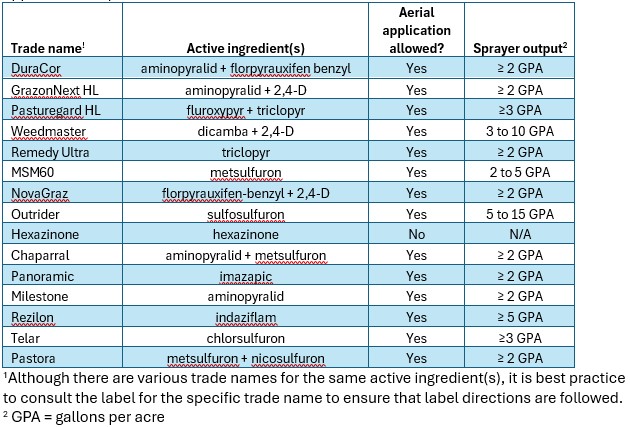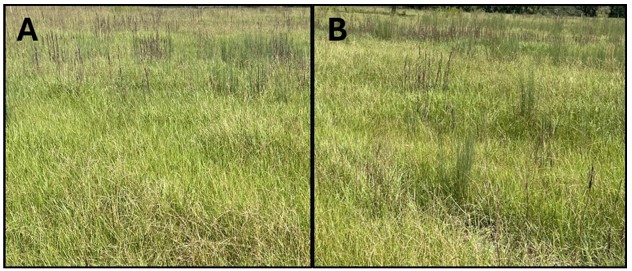
Drone Sprayer test for pasture weed control at Ona Range Cattle Research and Education Center. Credit: Brent Sellers, UF/IFAS
Dr. Brent Sellers and Dr. Tenzy Mncube, UF/IFAS Range Cattle Reserch and Education Center, Ona
Aerial pesticide applications are not new to the agriculture industry, but this type of application has increased in popularity due to improved technology of unmanned aerial vehicles (UAVs, drones, etc.; Figure 1). As with any new technology, many of us have questions regarding the application and effectiveness of herbicides using drones. Considering that most of us are used to sprayer outputs of at least 20 gallons per acre (GPA), it makes many of us uneasy about herbicide effectiveness when many drone applications are going out at less than 5 GPA.
First, we must look at the herbicide label to make sure that aerial applications are even allowable for a particular herbicide. A quick search of pasture herbicide labels reveals that almost all herbicides utilized for pasture weed control can be applied aerially (Table 1), with the only exception being hexazinone (Tide Hexazinone, Velossa, Velpar) in pastures. The applicator must follow the label restrictions, and most of them indicate that applications should not occur more than 10 ft above the crop canopy and mitigate spray drift as much as possible (each label has specific requirements).

Table 1. Common pasture herbicides with label-specified sprayer output volumes for aerial applications in pastures.
–
Rather than go into further legalities and regulations surrounding the use of drones for pesticide applications (for regulatory requirements regarding pesticide applications with drones, please visit: Regulatory Requirements to Operate Spraying Drones). We want to ensure that this technology will work for herbicides that we commonly use in pastures.
In July 2024, we set up an experiment to compare ground applications of DuraCor + Pasturegard HL (16 oz/A + 16 oz/A) or GrazonNext HL + Pasturegard HL (24 oz/A + 16 oz/A) at sprayer outputs of 10, 20, or 30 GPA with drone applications of these same herbicides and rates at an output of 2.5 GPA. The primary weed in the pasture was dogfennel at an average height of 36 inches.

Figure 2. Comparison of DuraCor + Pasturegard HL (16 oz/A + 16 oz/A) applied with a ground sprayer at 20 gallons per acre (A) or a drone at 2.5 gallons per acre (B)
–
Analyzing the data from this trial was easy. We saw no visible differences between the ground and the aerial application at 1 and 2 months after treatment (Figure 2). We also put the drone application to the test on an abandoned citrus grove with dogfennel exceeding 7 ft in height, and they were controlled using these herbicide mixes.
Our preliminary research indicates that drones could be utilized for pasture weed control and are just as effective as ground applications. However, we will hold back on recommendations until we have at least another year of data. Further, we may start looking at reduced herbicide rates, allowing for reduced weed management costs. Currently, drone applications cost at least $5 more per acre than a traditional ground application. However, drones can also be utilized to spray areas where ground equipment can’t always go, due to terrain and can also save wear and tear on ground equipment when driving through the never-ending hog rooting and smutgrass.
–
Acknowledgement: We would like to thank Hugh MacDonald and Chase Haley of Precision Agricultural Services for their assistance with the drone applications in our studies.
- The Use of Drones in Pasture Weed Management - June 20, 2025
- Goatweed Control in Pastures and Hayfields - October 4, 2019
- Thinning the Pawpaw Patch in Your Pastures - May 18, 2018
